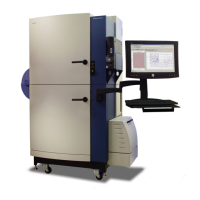FLIPR
®
Tetra High Throughput Cellular Screening System User Guide
0112-0109 H 25
To acquire quality data, reaffix the observation panel to the inner door
prior to running an experiment.
Liquid-Handling System
Compounds are transferred from source plates or reservoir to read
plates by the pipettor mounted on the rear wall of the top
compartment, above the TETRAcycler. The pipettor assembly can be
fitted with a standard pipettor head, to use disposable tips, or a pin tool
head, which uses solid or slotted pins to carry compound.
All 1536, 384, or 96 tips or pins operate at the same time,
simultaneously picking up compound from all the wells in a source plate
(or a quarter of the wells; see Compatible Plate Configurations on
page 30 below) or Cell Reservoir, and similarly dispensing these
simultaneously to the read plate. Fluid mixing steps can be configured
for source plates before compound is picked up, and for read plates
once it has been dispensed.
Pipettor heads are user-installable and can be interchanged in
approximately less than 5 minutes; see Exchanging Pipettor and Pin
Tool Heads on page 129.
Standard Pipettor Head
Standard pipettor heads are available in 1536-, 384- and 96-tip
formats.
The 384- and 96-pipettor heads both use disposable plastic tips. In
contrast, the 1536-pipettor head uses a stainless steel tip block with a
disposable 1536-tip gasket.
Plastic tips can be washed or replaced between each compound
addition or at the end of an experiment. The 1536-tip block is washed
at specified times.
WARNING! If pretending to run in luminescence mode with the
Aequorin ICCD camera, DO NOT touch the white door switches.
Room light will damage the Intensifier. The door switches
detect the open door to protect the camera.
Note: The observation panel should only be used to view internal
pipettor movement; it should not be used during experiments when
data is being accumulated. Test data (in the case of the Aequorin ICCD
camera) or compromised data (with the Standard camera) will be
shown if not collected under dark conditions with closed doors.

